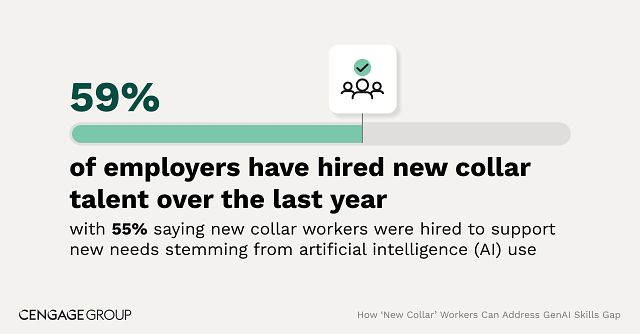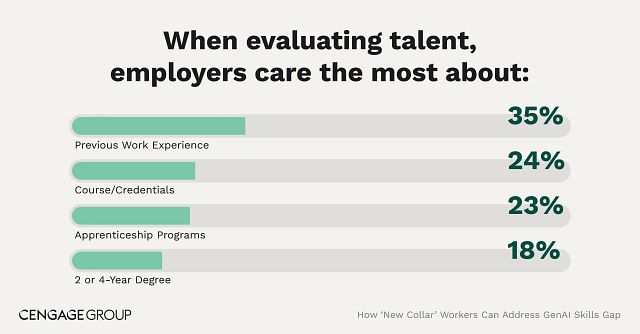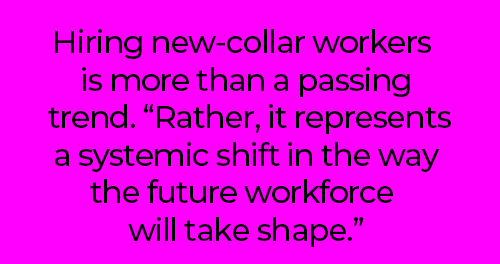GenAI & "New Collar" Connection
This Changes Everything!

Vitally needed workers for robot-driven manufacturing, and just maybe, the revitalization of America’s middle class.
They’re definitely a new breed!
Don’t call them blue collar and don’t call them white collar. Blue, many perceive as life-long drudgery with a wasted body by the age of fifty, and white as onerous college debt with the worst ROI imaginable.
They avoid large factories and mega warehouses where for every robot deployed three jobs go missing. Besides, those gigs are way up there on the blue-collar drudgery meter. They also shun white-collar offices that track keystrokes, screen email, and surveil worker productivity.
Around them, the world is just beginning to make room for their kind and see value in their non-traditional worldview. Colleges have dropped the SAT. Law schools jettisoned the LSAT. And now employers large and small are dropping the college degree requirement on resumes. A move that seems reasonable since 66% of the country’s population is without a college degree.
See related: States Are Leading the Effort to Remove Degree Requirements from Government Jobs.
As the NYT blared in a headline, which must have put a smile on the faces of all these new-breed contrarians: “Emerging fields like AI, EVs, and robotics feel like a new age in jobs is beginning to settle in, jobs that require advanced skills but not necessarily advanced degrees.”
Somewhere background music from X Ambassadors’ Renegade suddenly rises up full: “Hey, hey, hey, hey, hey, hey, living like we’re renegades. Two kids like you & me. Go forth and have no fear. Our time to break the rules. Let’s begin…”

Some have called them the future of manufacturing in America. “If industry is to invigorate and revitalize manufacturing, it must start with the new-collar workers who essentially make digital fabrication for Industry 4.0 possible.”
Back in 2016, IBM’s then-CEO Ginny Rometty gave them the moniker: “New Collar” workers. She said, “that new-collar jobs in many industries remain largely unfilled. The surprising thing,” she added, “is that not all of these positions require advanced education or require a traditional college degree. What matters most is that these employees have relevant skills, often obtained through vocational training.”
For nearly a decade after Rometty’s new-collar appellation, a germination process set in, helped along by the lingering aftereffects of The Great Recession of 2008, COVID, work from home, return to office, work-life balance, quiet quitting, digitalization, the rise of machine learning, and a heavy dose of inflation.
Suddenly, there they were by the millions, savvy, new-collar workers needing training and upskilling. They are smart, energetic, and most of all, they are young. A perfect combination for any American manufacturer. And now with the democratizing effects of generative AI (GenAI) influencing most everything there is that matters, they have an unparalleled opportunity to upgrade themselves and all of Industry 4.0. In fact, as pundits have long decried the “hollowing out of America’s middle class,” these young men and women workers may well be its revival and ultimate salvation.
New data from a Cengage Group survey indicates that the increased interest in hiring new-collar workers is more than a passing trend. “Rather, it represents a systemic shift in the way the future workforce will take shape. In short, the need for generative AI expertise is changing conventional wisdom in how we recruit, interview and hire tech talent, leaning into candidates with the right skills and competencies needed to work with AI and machine learning, no matter where they learned them.
The Era of the New Collar Worker survey polled 700 tech hiring managers and decision-makers in the U.S. Its goal was to explore whether employers were considering unconventional candidates for AI roles, the impact of these employees on their organizations and how hiring practices are evolving due to AI’s rapid rise. The findings provide a snapshot of just how dramatically AI is upending traditional hiring practices.

American manufacturers are facing a shortfall of two million unfilled manufacturing jobs by 2025. Such readily available jobs as computer numerical control (CNC) machining stations, lathes, lasers, robot-driven automation, sensor technologies, as well as Internet of Things (IoT), where operational data needs to be captured and analyzed, don’t require college grads but rather workers with advanced skills—typically one or two years of post-secondary education or vocational training.
“New-collar manufacturing jobs are also safer,” say the experts, and are “more intellectually challenging and offer better pay than traditional blue-collar jobs, making them more appealing to students graduating from high school, colleges and technical schools.”
On the road less traveled
According to Gray’s “New Collar” Workers Are the Future of Manufacturing, a closer look at the number and variety of jobs beginning to be angled toward this new breed of worker is truly amazing and far from blue-collar and white-collar stereotypes: cloud computing maintenance, security analysis and testing, data mining and statistical analysis, data storage engineering and management, user interface design, plus operational and maintenance skills for advanced machining equipment. In addition, new equipment—including additive manufacturing/3D printing— require machine managers, programmers, and real-time equipment maintenance and repair workers; and, of course, there’s that newest of no-college-necessary new skills in great demand—GenAI prompt engineering.

To date, the U.S. has about 500,000 industrial robots deployed. However, with only a bare 10% of America’s manufacturing automation needs met as of 2024, the outlook for several million more industrial robots being put to work over the next several decades is very real. In addition, humanoid robots have recently been added to the lists of robots headed toward factory work. Humanoid robot Digit will be produced in a “RoboFab” at the rate of 10,000 annually. Consequently, the manpower needs from new-collar workers could rise exponentially. Someone needs to maintain, service, and upgrade millions of industrial robots. Manufacturing sees an opportune match between robots and new-collar coming into view.
Is this us?
As industries from manufacturing to agriculture are reshaped by artificial intelligence (AI) and automation, jobs will and are being created that demand new skills. Not necessarily college-earned skills, but high-level skill-building and training.
According to Ray Kurzweil technology is an evolutionary process, like biology, only it moves from one invention to the next much faster. Technology goes beyond mere tool making, writes Kurzweil: it is a process of creating ever more powerful technology using the tools from the previous round of innovation.
The previous round of innovation has pushed machine learning and artificial intelligence into a new thing called GenAI, which is non-stop igniting brainstorms of new technology worldwide while turning what it is to work at a job on its head.
Sarah Boisvert, author of The New Collar Workforce and co-founder of the commercial division of Potomac Photonics, a manufacturer in Baltimore, Maryland, writes that technology has also evolved a new workforce to run and manage this fast-approaching new future, the New Collars.
“We live in a time of extraordinary opportunity,” writes Boisvert, “to look to the future and fundamentally change manufacturing jobs, but also to show people the value in new-collar jobs and to create nontraditional pathways to engaging, fulfilling careers in the digital factory.
As the Renegade song goes: “All hail the new kids…the Spielbergs and Kubricks…It’s our time to make a move. Let’s begin…”
